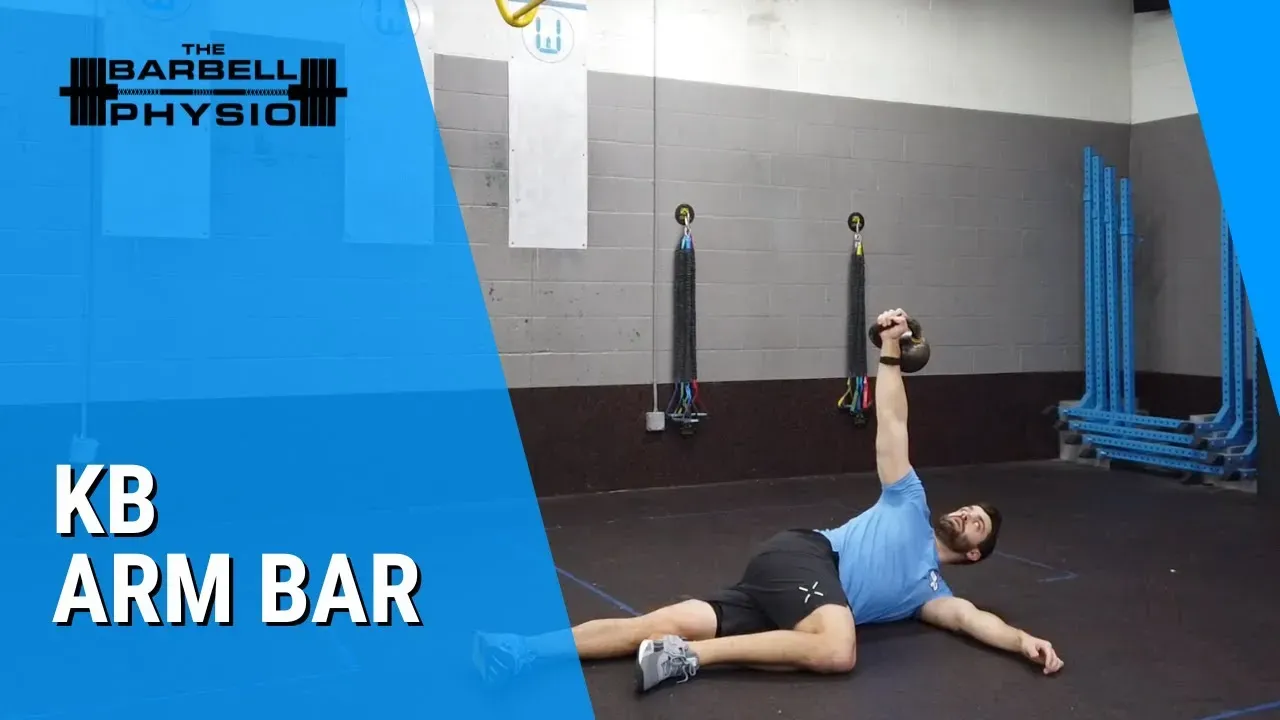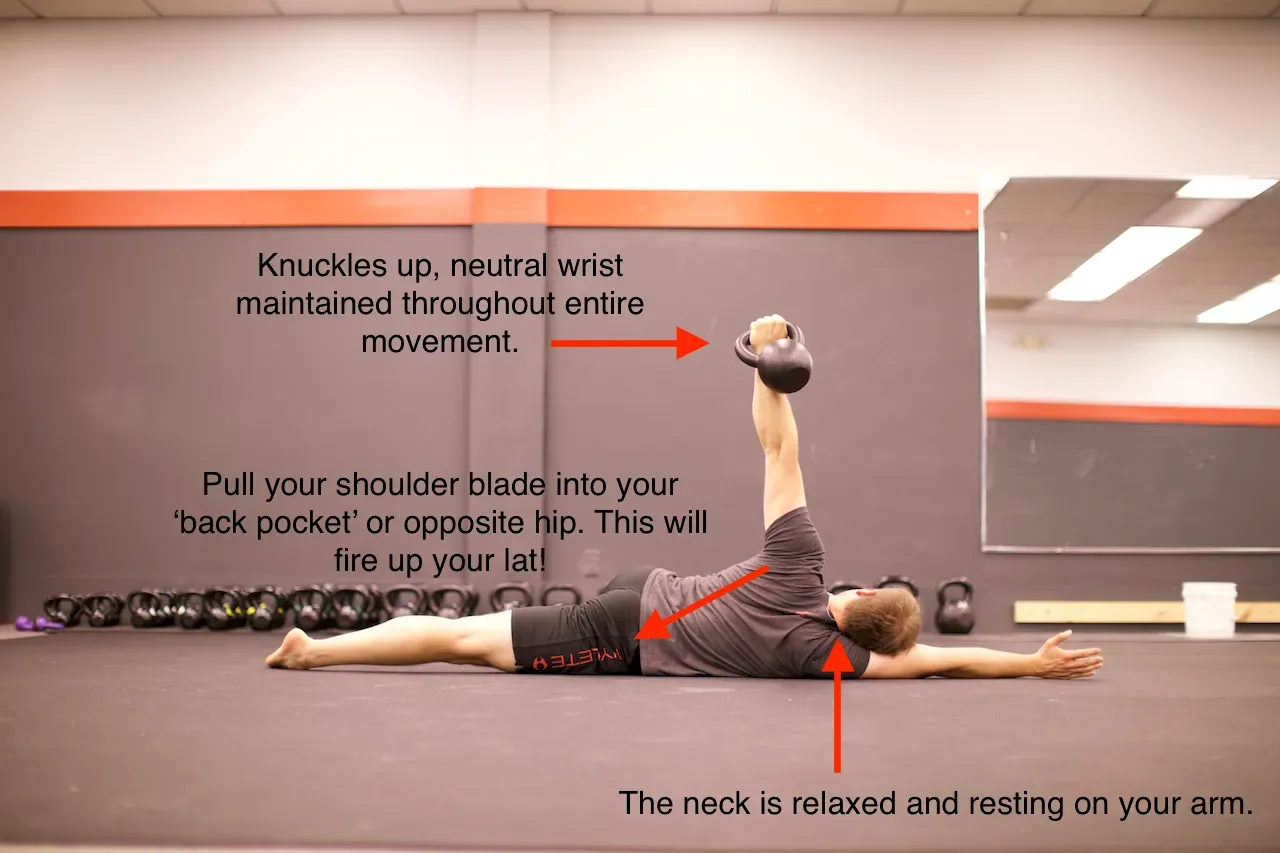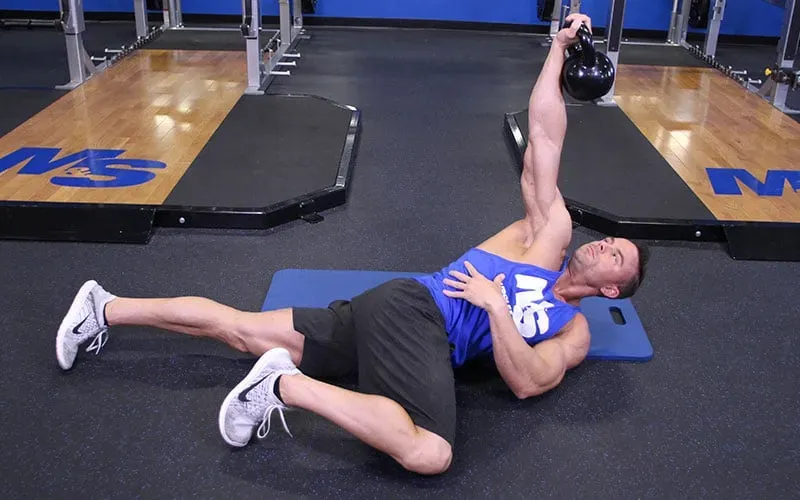Table of Contents
Ever feel like your shoulders are locked up? Or maybe you struggle with overhead movements, lacking that solid, stable feeling? You're not alone. Many people deal with shoulder stiffness and instability, which can sideline workouts and even make everyday tasks a pain.
Unlock Mobility and Stability with the Kettlebell Arm Bar Exercise

Unlock Mobility and Stability with the Kettlebell Arm Bar Exercise
More Than Just a Warm-Up
Let's be clear: the kettlebell arm bar exercise isn't some fluffy, feel-good stretch you just toss into the beginning of your session and forget about. This move is a foundational piece for building genuine shoulder health and resilience. Think of it as diagnostic and therapeutic. It immediately shows you where your restrictions are, and with consistent practice, it systematically works to iron them out. Many folks treat it like a simple mobility drill, but they're missing the point. It's actively engaging your deep stabilizing muscles while simultaneously coaxing your joint capsule and surrounding tissues into a better range of motion.
Unlocking Your Range of Motion
The magic in the arm bar for mobility happens as you slowly rotate your body away from the arm holding the kettlebell. This isn't a race; it's a deliberate unwind. As you turn, allowing your hips and upper back to follow, you create a long lever that gently pulls on the shoulder joint. Done correctly, you feel a stretch across the chest, through the shoulder, and potentially into the lats. It’s not about forcing the range, but exploring what's available and encouraging a little more each time. I've seen people gain noticeable improvements in overhead reach and comfort after just a few sessions focusing on mindful rotation.
- Improves thoracic spine rotation
- Increases shoulder external rotation
- Stretches chest and lats
- Enhances overall overhead position
Building Bulletproof Stability
Holding a kettlebell directly overhead while you're lying on your back, then rotating your body underneath it, is inherently unstable. That's the beauty of it. Your rotator cuff, the small muscles you rarely think about until they complain, goes into overdrive. Your serratus anterior, often called the "boxer's muscle," has to work hard to keep your shoulder blade stable against your rib cage. It forces your core to engage in a less conventional way, tying everything together. This isn't brute strength; it's intelligent strength, teaching your body to manage load in vulnerable positions. That translates directly into better performance and injury prevention in everything from pressing movements to throwing a ball.
StepbyStep Guide: Performing the Kettlebell Arm Bar Exercise

StepbyStep Guide: Performing the Kettlebell Arm Bar Exercise
Getting Set Up for the Kettlebell Arm Bar
Alright, let's get down to the nitty-gritty of actually doing the kettlebell arm bar exercise. Don't just grab the heaviest bell you see; start light. Seriously light. A 4kg or 6kg bell is often plenty to learn the movement and feel what's happening. Lie down on your back, knees bent, feet flat on the floor. Position the kettlebell on the floor beside you, on the side you plan to start with. Roll onto that side and use both hands to grasp the kettlebell handle. Pull it close to your chest, then carefully roll back onto your back, keeping the bell held securely with both hands over your chest.
Once you're flat on your back with the bell held over your chest, press it straight up towards the ceiling with the arm that's on the same side as the bell. Your other arm can rest on the floor out to the side, maybe at a 45-degree angle, for balance. Keep your eyes fixed on the kettlebell the entire time. This isn't optional; it's a critical safety cue that helps maintain shoulder stability and prevents the bell from wandering into a dangerous position.
Executing the Roll and Rotation
With the kettlebell pressed overhead and your eyes locked on it, begin the movement by rolling your body away from the arm holding the bell. Drive through the foot on the same side as the bell, allowing your opposite leg to cross over your body. Think about rotating from your hips and thoracic spine. Your goal isn't to get into a specific yoga pose, but to gently roll onto your side. Keep that arm locked out, elbow straight, and the kettlebell directly over your shoulder joint. Don't let the bell drift forward, backward, or side-to-side. Imagine a straight line from the bell, through your wrist, elbow, and shoulder, all the way down to the floor.
As you roll, you'll end up mostly on your side, supported by your bottom arm and possibly your crossed-over leg. Hold this position for a few breaths, feeling the stretch across your chest and shoulder. Maintain control of the kettlebell overhead. This is where the stability work really kicks in. To return, simply reverse the motion, slowly and deliberately rolling back onto your back, keeping your eyes on the bell until you are flat again. Lower the bell back down to your chest with both hands, then carefully place it back on the floor by rolling to the side.
Key Step | Focus Point |
|---|---|
Starting Position | Lie on back, bell beside you. Use two hands to secure bell. |
Press Overhead | Press bell straight up with working arm. Eyes on bell. |
Initiate Roll | Drive through same-side foot, cross opposite leg. |
Rotate Body | Roll away from bell, lead with hips/thoracic spine. |
Hold Position | Maintain lockout, bell over shoulder. Breathe. |
Return | Slowly reverse roll back to starting position. |
Tips and Tricks for a Perfect Kettlebell Arm Bar Exercise

Tips and Tricks for a Perfect Kettlebell Arm Bar Exercise
so you've got the basic motion down for the kettlebell arm bar exercise. Now, let's talk about making it *good*. The biggest mistake I see? Rushing it. This isn't a burpee; speed kills the benefits here. Think slow, controlled, and deliberate. Another common issue is letting the wrist bend or the elbow unlock. That bell needs to stay stacked directly over your shoulder joint like a laser beam pointing at the ceiling. If your wrist is flopping or your elbow is soft, you're not building stability; you're just asking for trouble. Keep tension through the arm, like you're trying to push the bell through the roof.
Kettlebell Arm Bar Exercise: Who Benefits Most?

Kettlebell Arm Bar Exercise: Who Benefits Most?
For Athletes and Lifters Seeking Resilient Shoulders
If you're an athlete who throws, swings, or lifts heavy things overhead, the kettlebell arm bar exercise should be in your rotation. Think baseball pitchers, volleyball players, swimmers, weightlifters, and CrossFitters. These activities demand a lot from your shoulder joint – stability under load, mobility through a wide range of motion, and the ability to absorb and produce force efficiently. The arm bar directly addresses these needs. It teaches your shoulder to stay centered in the socket while your body moves around it, mimicking the demands of sport. It highlights imbalances you might not even know you have, forcing weaker stabilizers to step up. Ignoring this kind of foundational stability work is like building a house on sand; eventually, it catches up to you, often in the form of nagging pain or injury.
Anyone who presses overhead, whether it's barbells, dumbbells, or kettlebells, also benefits immensely. A solid overhead press starts with a stable shoulder blade and a mobile thoracic spine, two things the arm bar actively improves. It helps you find a safer, stronger overhead position, reducing the strain on your shoulder capsule and rotator cuff during heavy lifts. It’s not a replacement for pressing, but a critical pre-requisite for doing it well and staying healthy long-term. I've seen lifters unlock stubborn plateaus in their overhead press simply by incorporating consistent arm bar work.
- Overhead athletes (pitchers, swimmers, throwers)
- Weightlifters and powerlifters
- CrossFit athletes
- Anyone with a history of shoulder instability
- Individuals looking to improve overhead lifting mechanics
Addressing Everyday Stiffness and Poor Posture
You don't need to be a high-level athlete to benefit from the kettlebell arm bar exercise. If you spend a lot of time sitting at a desk, driving, or just dealing with the general stiffness that comes with modern life, this exercise can be a game-changer. Poor posture often leads to rounded shoulders, tight chests, and restricted upper back movement. This limits your ability to reach overhead comfortably or even just stand tall without feeling stiff. The arm bar gently helps to counteract these issues. By rotating your body away from the held weight, you encourage extension through the thoracic spine and open up the chest, helping to pull your shoulders back into a better position.
It's also a surprisingly effective way to improve body awareness. Holding the bell overhead requires focus and control, making you more mindful of how your shoulder blade is positioned and how your core is engaged. This awareness carries over into daily activities, helping you move more efficiently and with less discomfort. Think of it as hitting a reset button for your upper body mechanics. A few minutes of arm bars can make a surprising difference in how 'open' and mobile you feel, counteracting hours spent hunched over.
Your Kettlebell Arm Bar Exercise Questions Answered

Your Kettlebell Arm Bar Exercise Questions Answered
so you've seen the kettlebell arm bar exercise, maybe you've even given it a shot, and now you've got questions swirling. That's good. It means you're thinking about the movement, not just rushing through it. People often ask about weight selection – again, start lighter than you think, focus on control and range of motion first. Another common one is, "Why does my wrist hurt?" Usually, that's because you're not stacking the weight properly or keeping tension through the arm; the bell should feel weightless on your hand, not like it's crushing your wrist. And what about frequency? You can do this daily if you like, especially with a light weight, as part of a warm-up or cool-down. It's low-impact and high-reward for shoulder health. Let's tackle a few more common queries right here.
- How heavy should the kettlebell be?
- Why am I feeling discomfort in my wrist or elbow?
- How often should I perform the arm bar?
- Can I do this if I've had a shoulder injury?
- What's the difference between this and a Turkish Get-Up?
Wrap Up: Your Shoulders Will Thank You (Eventually)
So, there you have it. The kettlebell arm bar exercise isn't a magic bullet, but it's a seriously effective tool for tackling shoulder mobility and stability issues. It might feel awkward at first, like trying to fold a fitted sheet, but stick with it. Consistent practice can lead to noticeable improvements, helping you move better both in the gym and in daily life. Don't expect instant miracles, just steady progress. Add the kettlebell arm bar exercise to your routine, pay attention to the details, and give your shoulders the chance to function like they're supposed to.